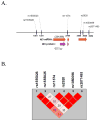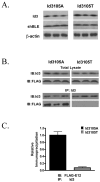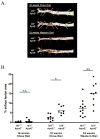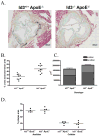Id3 is a novel atheroprotective factor containing a functionally significant single-nucleotide polymorphism associated with intima-media thickness in humans
- PMID: 20185798
- PMCID: PMC2860382
- DOI: 10.1161/CIRCRESAHA.109.210294
Id3 is a novel atheroprotective factor containing a functionally significant single-nucleotide polymorphism associated with intima-media thickness in humans
Abstract
Rationale: The gene encoding the helix-loop-helix transcription factor Id3 (inhibitor of differentiation-3) is located within atherosclerosis susceptibility loci of both mice and humans, yet its influence on atherosclerosis is not known.
Objective: The present study sought to determine whether polymorphisms in the ID3 gene were associated with indices of atherosclerosis in humans and if loss of Id3 function modulated atherogenesis in mice.
Methods and results: Six tagging single-nucleotide polymorphisms (SNPs) (tagSNPs) in the human ID3 gene were assessed in participants of the Diabetes Heart Study. One tagSNP, rs11574, was independently associated with carotid intima-media thickness (IMT). The human ID3 variant at rs11574 results in an alanine to threonine substitution in the C terminus. To determine the effect of this polymorphism on the basic function of Id3, site-directed mutagenesis of the human ID3 gene at rs11574 was performed. Results demonstrated a significant reduction in coimmunoprecipitation of the known E-protein partner, E12, with Id3 when it contains the sequence encoded by the risk allele (Id3105T). Further, Id3105T had an attenuated ability to modulate E12-mediated transcriptional activation compared to Id3 containing the ancestral allele (Id3105A). Microarray analysis of vascular smooth muscle cells from WT and Id3(-/-) mice revealed significant modulation of multiple gene pathways implicated in atherogenesis. Moreover, Id3(-/-)ApoE(-/-) mice developed significantly more atherosclerosis in response to 32 weeks of Chow or Western diet feeding than Id3(+/+)ApoE(-/-) mice.
Conclusions: Taken together, results provide novel evidence that Id3 is an atheroprotective factor and link a common SNP in the human ID3 gene to loss of Id3 function and increased IMT.
Conflict of interest statement
Figures





References
-
- Geng YJ, Libby P. Progression of atheroma: a struggle between death and procreation. Arteriosclerosis, thrombosis, and vascular biology. 2002;22:1370–1380. - PubMed
-
- Stary HC. Natural history and histological classification of atherosclerotic lesions: an update. Arteriosclerosis, thrombosis, and vascular biology. 2000;20:1177–1178. - PubMed
-
- Berenson GS, Srinivasan SR, Bao W, Newman WP, 3rd, Tracy RE, Wattigney WA. Association between multiple cardiovascular risk factors and atherosclerosis in children and young adults. The Bogalusa Heart Study. N Engl J Med. 1998;338:1650–1656. - PubMed
-
- Lusis AJ, Mar R, Pajukanta P. Genetics of atherosclerosis. Annu Rev Genomics Hum Genet. 2004;5:189–218. - PubMed
Publication types
MeSH terms
Substances
Grants and funding
- R01 HL62522/HL/NHLBI NIH HHS/United States
- F32 HL085989/HL/NHLBI NIH HHS/United States
- 5-T32 HL007355-29/HL/NHLBI NIH HHS/United States
- R01 HL067348/HL/NHLBI NIH HHS/United States
- R01 HL136098/HL/NHLBI NIH HHS/United States
- M01 RR007122/RR/NCRR NIH HHS/United States
- P01 HL55798/HL/NHLBI NIH HHS/United States
- R01 HL062522/HL/NHLBI NIH HHS/United States
- T32 HL007355/HL/NHLBI NIH HHS/United States
- R01 HL67348/HL/NHLBI NIH HHS/United States
- M01 RR07122/RR/NCRR NIH HHS/United States
- P01 HL055798/HL/NHLBI NIH HHS/United States
LinkOut - more resources
Full Text Sources
Medical
Molecular Biology Databases
Miscellaneous

